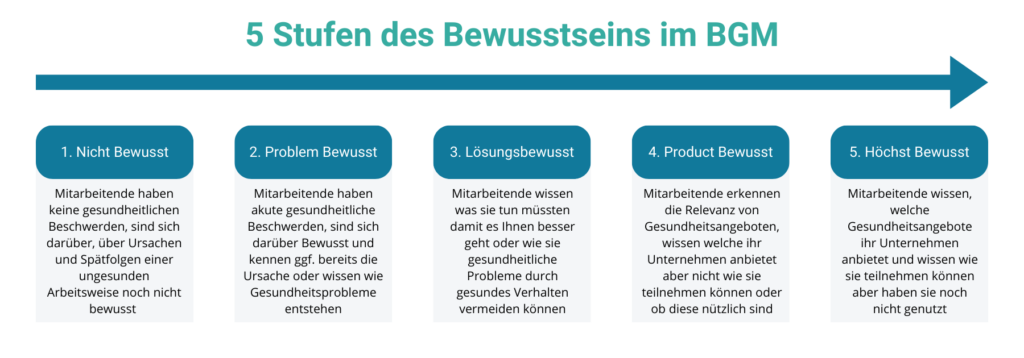
Are you passionately committed to the health of your colleagues by campaigning for more resources for occupational health management? Do you regularly conduct employee surveys to find out what stresses and wishes exist in the company? Do you put together a varied health programme based on the surveys but the participation rate is still low? If you answered "yes" to these questions, you are not alone. Surveys show that many OHM managers are not satisfied with the response to their programmes. In individual cases, there can be many reasons for this, e.g. the programmes are not tailored to the needs of the employees. In most cases, however, it is due to something much more mundane: the OHM measure was not communicated correctly.
What are occupational health management measures?
What health promotion measures are available?
Why good communication is important
Why good OHM often fails due to communication
Increase participation rate in BGM measures through targeted communication
5 tips for BGM communication measures
Measures for Company health management are activities aimed at promoting the health of the workforce. They include various aspects that serve to analyse working conditions, identify potential stresses and then eliminate them.
Various measures can be planned and implemented in all three pillars of OHM. Workplace health promotion (WHP) aims to promote the health of employees through preventative measures and to improve well-being in the workplace. Company integration management (BEM) helps employees who have lost their ability to work due to health restrictions to be reintegrated into the work process. Occupational health and safety includes measures aimed at preventing accidents and damage to health in the workplace.
In general, a distinction is made in preventive measures between Behavioural and situational prevention. Relational prevention is concerned with changing workplace conditions, whereas behavioural prevention aims to change individual behaviour. Both types of prevention are aimed at changing the Reduce sickness rates.
Within these areas, there are health-promoting measures that focus on mental well-being and measures that focus on physical health or ergonomics. Both are extremely important for health and well-being in the workplace.
Overall, the measures serve to optimise working conditions and protect the health of employees. Through targeted measures, companies can benefit from healthier and happier employees in the long term, which has a positive effect on performance and the working atmosphere. The overriding goal is to achieve a long-term and systematic change in behaviour.

There are a variety of measures in a BGM strategy that contribute to health promotion in the workplace. These are not only measures from external providers, but also measures that can be implemented internally. We have compiled a few measures here to serve as inspiration. Selected measures are described in detail.
We have picked out various measures and explained them in more detail. We have also summarised the advantages and disadvantages of each measure.
Health days, where various offers such as health checks, counselling or workshops on the subject of health and prevention are offered.
Another important aspect is the promotion of an ergonomic workplace. The aim here is to organise working conditions in such a way that physical strain is reduced and poor posture is avoided. Ergonomic furniture, work materials and adjustments to work processes can contribute to this.
An ergonomics coach can be used to support employees in matters of ergonomics, offering individual consultations and training. Or you can use a digital ergonomics coach who is there for your employees on a permanent basis. In this way, employees learn in the long term what is important for their body and posture.
Healthy eating and regular exercise also play an important role in employee health. This includes, for example, programmes to promote healthy meals in company restaurants.
Health apps can also be used to support employees in monitoring and promoting their health. For example, such apps offer the opportunity to track sporting activities, keep food diaries and set individual health goals.
A fitness programme can be implemented either via an in-house gym on the company premises or via a partnership with a company fitness provider. When partnering with a large platform, employees have the flexibility to choose which programmes they want to use.
Mental health is becoming increasingly important as the shortage of skilled labour leads to more stress in the workplace. In recent years, absenteeism due to a lack of mental health has increased enormously. This is costing companies a lot of money and yet there are still many who do not carry out a mental health risk assessment, even though it is mandatory as part of the risk assessment. However, providers have recognised this negative trend and offer mental health seminars and workshops, for example.
Relatively new on the market are platforms that offer therapy sessions (1-to-1 or groups) via video calls. This allows employees from anywhere in the world to talk to trained psychologists about private and professional issues and reduce mental stress.
Soft Fridays are a trend that is currently emerging in the USA and is slowly spilling over into Germany. The basic idea behind it: Employees decide for themselves how long and from where they work on a sunny Friday in summer. The idea is to give employees the freedom to make the most of the beautiful summer days. Soft Fridays do not have an agenda, which is why it is important to set deadlines for important projects on Thursdays. This creates more free time on a Friday, which can be used for activities that can also be done in the garden or park, for example. This does not mean that employees should suddenly only work four days or that Friday is half a working day. Rather, employees should be encouraged to organise and complete their tasks in such a way that they can complete lighter and location-independent tasks on Fridays. For example, this can be used for further training.
Brownbag meetings allow employees to come together in the office or virtually and learn new things. The meetings take place over lunch and you can, for example, always choose a person to present something that the others do not yet know. This not only creates sustainable knowledge about processes, procedures and tasks, but can also be used for health issues. For example, in most companies there are people who deal a lot with nutrition or sport, while others would like to learn more about it.
Isa is an artificial intelligence that makes it very easy to implement OHM. The innovative sensor technology and AI-supported analysis of the posture and movement of the person sitting at the desk provides information that ensures better ergonomics and more movement at the workplace. This creates health-promoting routines and keeps you healthy in the long term.
Overall, a holistic understanding of occupational health management is of great importance in order to maintain the health and performance of employees in the long term. But what if participation rates are too low?
In OHM, a good communication strategy is the be-all and end-all for the successful implementation of OHF measures. But why is that the case?
Occupational health management in its current form and character is a relatively new element of strategic corporate management. Many employees do not realise that there is a health management system in the company and what it offers. Health promotion has long offered more than boring training courses on how to sit upright or adjust your office chair correctly - make your colleagues aware of this!
As an attractive OHM is new to many employees, it is like introducing a new product. Only when consumers know that a certain product exists, what purpose it fulfils and how to acquire it, will there be a demand for it. For the OHM, this means communicating specifically what offers are available, what purpose they fulfil and how participation takes place.
Often only a small part of the workforce is addressed, who either have a very committed manager and are interested in it themselves. This brings us to the reason why a great OHM programme may not have the desired effect due to incorrect communication.
The reason why workplace health promotion only reaches a fraction of the workforce and often always the same people is very simple: Only a fraction of the workforce is actually addressed. Why this is the case becomes clear when we analyse the internal communication for OHM measures using the 5 levels of consciousness analyse.

The diagram shows five different levels into which employees can be categorised. As a rule, health programmes appeal to everyone from level 2 onwards. These are, on the one hand, people who have health complaints and, on the other, people with a high level of health awareness, often also the "sports enthusiasts" who take part in every OHM programme.
However, the majority of employees are in level 1 because they are either less health-conscious or have no complaints and therefore do not feel addressed. For example, preventative measures for musculoskeletal disorders, which are one of the most common causes of days lost due to illness, rarely appeal to young talent. Even though statistics show that young people also suffer from back or neck problems, this group finds it difficult to admit it or does not realise that their "sedentary" lifestyle puts them at high risk of further complaints.
In the next section, we will show you how you can increase the participation rate through targeted BGM communication.
The purpose of internal communication on occupational health management measures is to move as many employees as possible from their current level to the next. Even if an employee moves from level 2 to 3 through communication, this is already a success for the company. Although this person has not yet signed up for a health programme, the risk of illness has already been reduced.
As there are employees in each of the five levels at any time, you can now use them to create different target groups. Each of these target groups can be reached individually with a suitable message. By conducting employee surveys, you can find out what percentage of employees are in which stage. This enables prioritisation.
Use all communication channels for your OHM:
This increases the likelihood that employees will receive the message.
Possible channels are: Intranet, internal newsletters & blogs, chats & instant messaging tools, social media, face-to-face meetings, notice board, company wiki, e-mail, employee magazine, meetings, staff meetings.
Pay attention to the correct wording:
It is important to know the needs of employees and to address them clearly. In addition, benefits should always be formulated from the employee's perspective and addressed in an appreciative manner. Headlines and address lines should also be formulated in an emotionally appealing way.
Communicate the low-threshold nature of OHM measures:
If employees are in stage 5 but have not yet registered for health programmes, this is often due to perceived hurdles. Such hurdles arise when employees think they don't have time, superiors show no understanding for participation in programmes or it is not clear how to register for programmes.
Take into account the timing and frequency of the approach:
Health programmes must be communicated in good time so that employees can keep the date free. Regular reminders also ensure a higher participation rate. A higher frequency of communication of OHM measures implies that you not only advertise specific offers, but also regularly send out information material. This also offers the opportunity to create awareness of the problem.
Design appealing communication documents:
Nobody likes to read an email from the company health management team if they are overwhelmed by facts and text. Appealing images, emotional language and little text ensure that your messages are read.